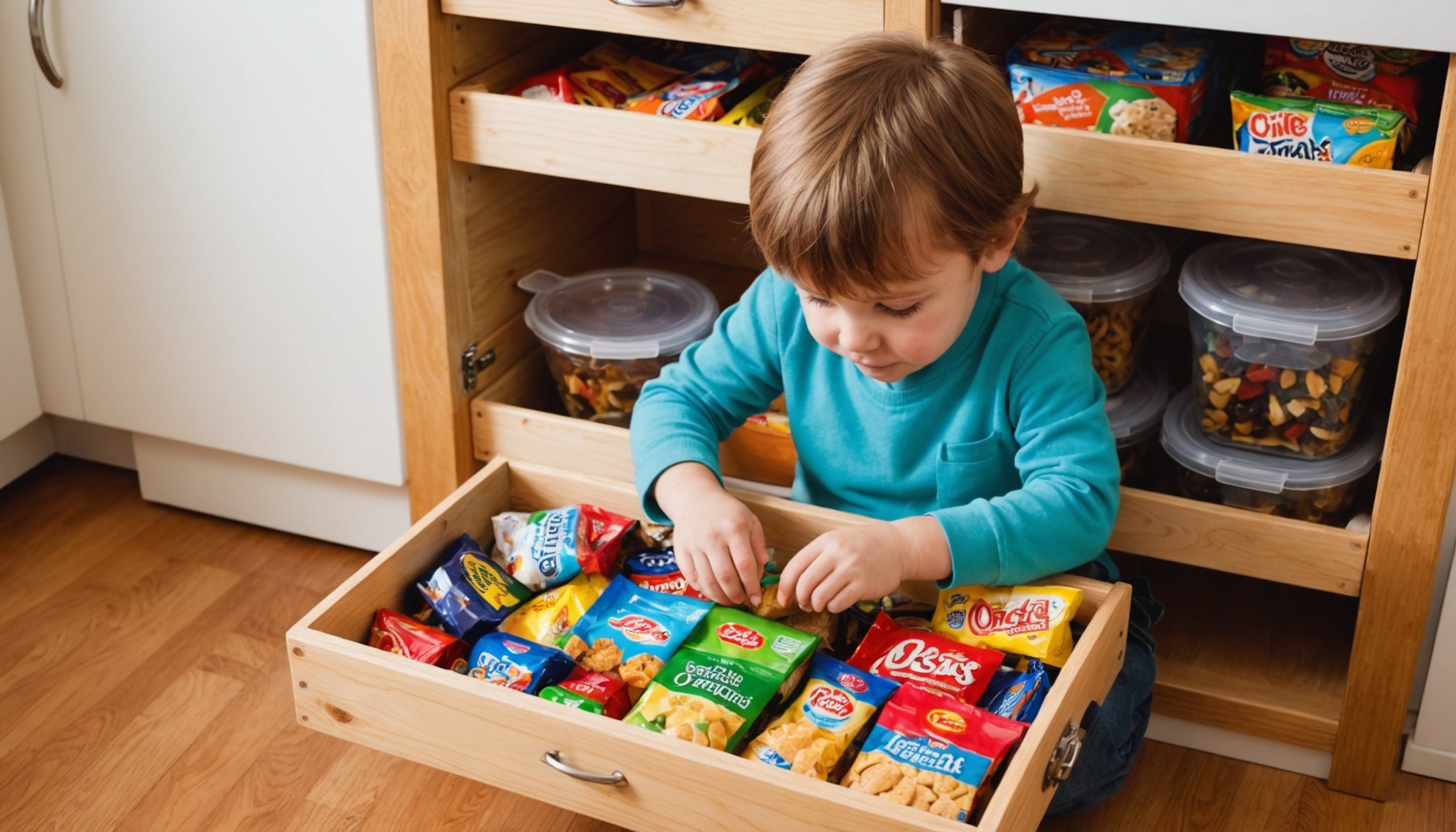Parents often face the challenge of managing their children's snacking habits while promoting healthy choices. Creating a low-height snack drawer can encourage independence and better portion control. This strategic approach helps kids make informed decisions about their snacks, reducing the likelihood of overeating. By implementing practical tips and thoughtful organization, you can transform your kitchen into a haven for healthy snacking that empowers children and supports their growth. Explore effective strategies to craft a snack drawer that aligns with your family’s nutritional goals.
Designing the Low-Height Snack Drawer
Creating a kid-friendly space for snacks
Also to discover : Maximize Freshness and Minimize Waste: The Ultimate Guide to Bread Storage Solutions for Compact Kitchens
Importance of Accessibility for Children
Designing a snack drawer with accessibility in mind ensures children can independently grab their favorite treats. Placing the drawer at a low-height allows even the youngest family members to reach it safely. A kid-friendly organization is crucial—consider using dividers or small bins to keep snacks neatly sorted. This not only makes it easier for children to find what they want but also encourages them to organize their space.
Choosing an Appropriate Location for the Drawer
Selecting the right spot for your snack drawer is vital. Ideally, it should be in a common area like the kitchen or dining room, where children frequently visit. Ensure the location is away from potential hazards, such as the stove or sharp utensils. This promotes a safe environment while maintaining the kid-friendly organization.
Also to discover : Ideal Positions for Kitchen TVs or Screens: Minimize Distractions While Cooking!
Materials and Tools Needed for Construction
Building a snack drawer requires some basic materials and tools. Consider using durable materials like wood or sturdy plastic for longevity. Essential tools include a drill, screwdriver, and measuring tape. Here's a simple list to get started:
- Materials: Wood or plastic panels, drawer slides
- Tools: Drill, screwdriver, measuring tape
By focusing on these elements, you can create a functional and inviting snack drawer for your children.
Selecting Healthy Snacks
Incorporating nutrition into your snack drawer
Nutritional Guidelines for Children's Snacks
When stocking your snack drawer, consider nutritious options that align with children's dietary needs. Snacks should provide essential vitamins and minerals while being low in added sugars and unhealthy fats. Aim for a balance of fruits, nuts, and yogurt to ensure a variety of nutrients.
Recommended Snack Options
To keep your snack drawer exciting and healthy, consider these nutritious options:
- Fruits: Apples, bananas, and berries are great sources of vitamins.
- Nuts: Almonds and walnuts offer healthy fats and protein.
- Yogurt: Choose plain or low-sugar varieties for calcium and probiotics.
Incorporating Variety to Prevent Boredom
A diverse selection of healthy snacks for kids can help maintain their interest and prevent snack-time monotony. Rotate between different types of fruits, nuts, and yogurt to keep things fresh. This not only supports a balanced diet but also encourages children to try new flavors and textures.
By focusing on these nutritious options, you can create a snack space that supports your child's health and keeps them engaged.
Portion Control Strategies
Implementing effective methods for managing snack portions
Using Containers for Predetermined Portions
One of the most effective ways to manage portion control for kids is by using containers for predetermined portions. This not only helps in maintaining the right serving sizes but also makes it easier for children to understand limits. Consider investing in small, reusable containers or snack bags. This method encourages kids to take responsibility for their own snacks and reduces the chances of overeating.
Teaching Kids About Serving Sizes
Educating children about serving sizes is crucial for developing healthy eating habits. Engage them in activities that involve measuring and comparing different food portions. Use visual aids like a portion control chart to illustrate what a balanced snack looks like. This hands-on approach makes learning about serving sizes fun and interactive.
Creative Ways to Limit Access to Larger Quantities
Limiting access to larger quantities can be achieved through creative methods. Introduce a "snack station" where only a daily allowance of predetermined portions is available. Encourage your children to pick their snacks for the day, teaching them to plan and make informed choices. This strategy not only supports portion control but also fosters independence and decision-making skills.
Psychological Insights on Eating Behaviors
Exploring the factors influencing children's eating habits
Understanding Triggers for Overeating in Children
Children's eating habits often develop from environmental and psychological influences. Recognizing triggers for overeating can help in managing these behaviors. Common triggers include emotional stress, boredom, and exposure to unhealthy foods. Understanding these can empower parents to create strategies that mitigate the desire to overeat.
The Role of Environment in Shaping Eating Habits
The environment plays a crucial role in shaping children's eating habits. A cluttered kitchen or a lack of routine can lead to disorganized eating patterns. Creating a structured environment with designated eating areas and regular meal times fosters healthier habits. This approach encourages mindful eating and helps children develop a positive relationship with food.
Techniques to Foster Mindful Eating
Encouraging mindful eating helps children become more aware of their eating habits. Techniques such as eating without distractions, savoring each bite, and recognizing hunger cues can be beneficial. Use a simple bulleted list to illustrate these methods:
- Eat without screens or distractions
- Focus on the taste and texture of food
- Pause between bites to assess fullness
Implementing these techniques can promote healthier eating habits and reduce the likelihood of overeating.
Visual Aids and Labels
Enhancing snack drawer accessibility through effective labeling
The Importance of Clear Labeling for Kids
Snack drawer labeling is essential in helping children independently choose their snacks. By using clear and simple labels, you can guide them towards making healthier choices. Labels serve as visual cues that not only identify the contents but also reinforce visual organization within the drawer. This organization can empower children to make decisions confidently and safely.
Creative Labeling Ideas to Engage Children
Engaging children in the process of snack drawer labeling can be both fun and educational. Consider using colorful stickers or illustrations that represent the snack categories. For example, a small apple icon for fruit snacks or a nut symbol for nuts. This creative approach not only enhances visual organization but also makes the snack drawer more inviting and user-friendly for children.
Using Visual Aids to Promote Healthy Choices
Visual aids can effectively promote healthy snack choices. Incorporate a bulleted list of healthy options next to the snack drawer. This list can remind children of nutritious choices available to them:
- Fresh fruits
- Whole-grain crackers
- Low-fat yogurt
By integrating these visual strategies, you ensure that the snack drawer labeling system is both functional and engaging, encouraging children to make informed and healthy choices.
Involving Kids in Snack Preparation
Encouraging participation in the kitchen for healthy habits
Benefits of Children Participating in Snack Preparation
Involving kids in the kitchen fosters a sense of responsibility and independence. When children participate in snack preparation, they learn about nutrition and develop essential cooking skills. This hands-on experience can lead to healthier eating habits as they become more invested in what they consume. Moreover, cooking together strengthens family bonds and encourages teamwork.
Simple Recipes to Encourage Involvement
To engage children in the kitchen, start with simple recipes that are both fun and educational. Consider these easy snack ideas:
- Fruit Kabobs: Let kids choose their favorite fruits to assemble on skewers.
- Veggie Wraps: Provide a variety of vegetables and spreads for a customizable wrap.
- Trail Mix: Allow children to mix nuts, seeds, and dried fruits for a personalized snack.
These recipes are not only nutritious but also build excitement around healthy snacking.
Building Excitement Around Healthy Snacking
Creating a positive and enthusiastic atmosphere in the kitchen can make healthy cooking appealing to children. Use colorful utensils and involve them in decision-making processes like selecting ingredients. Celebrate their culinary creations to boost confidence and make healthy snacking a fun, regular activity. This approach encourages children to appreciate the benefits of nutritious foods.
Expert Recommendations and Resources
Enhancing knowledge on child nutrition through expert insights
Recommended Books and Articles on Child Nutrition
Exploring nutrition expert advice can significantly enhance your understanding of children's dietary needs. Books like "Child of Mine: Feeding with Love and Good Sense" by Ellyn Satter offer comprehensive insights into parenting resources for healthy eating habits. Articles in journals such as the "Journal of Nutrition Education and Behavior" provide evidence-based strategies to incorporate into daily routines.
Interviews or Quotes from Nutritionists
Gaining perspectives from professionals is invaluable. Nutritionist Jane Doe states, "Involving children in meal planning fosters a positive relationship with food." This nutrition expert advice emphasizes the importance of engagement in dietary choices. Such insights are crucial parenting resources that guide families in nurturing healthy eating behaviors.
Online Resources for Further Learning
The internet hosts a wealth of parenting resources for those seeking further education. Websites like the Academy of Nutrition and Dietetics offer a plethora of nutrition expert advice through articles, webinars, and interactive tools. These platforms serve as a foundation for expanding your knowledge and implementing effective dietary strategies.
- Books: "Child of Mine" by Ellyn Satter
- Articles: "Journal of Nutrition Education and Behavior"
- Websites: Academy of Nutrition and Dietetics
By utilizing these resources, families can make informed decisions about their children's nutrition.
Monitoring and Adjusting the Snack Drawer
Ensuring the snack drawer remains appealing and nutritious
Regular Assessment of Snack Drawer Contents
Maintaining a snack drawer that meets your children's needs requires ongoing evaluation. Regularly assess the contents to ensure they remain fresh and appealing. This involves checking for expired items and replacing them with new, nutritious options. By keeping the snack drawer organized and up-to-date, you can continually support your child's healthy eating habits.
Adapting Selections Based on Preferences
Children's tastes can change frequently, making it essential to adapt the snack drawer selections accordingly. Pay attention to which snacks are popular and which are consistently left untouched. Involve your children in choosing new snacks to keep them engaged and invested in their eating choices. This practice not only refreshes the snack drawer but also encourages children to explore a wider range of foods.
Tracking Eating Habits for Improvements
Monitoring your children's eating habits can provide valuable insights into their nutritional needs. Keep a simple record of snack choices and frequency to identify patterns. This information can guide adjustments to the snack drawer contents, ensuring it remains a beneficial resource. Implementing these strategies can lead to improved eating habits and a more effective snack drawer system.
- Regular checks for expired items
- Involve children in snack selection
- Track snack choices and frequency











